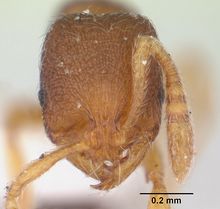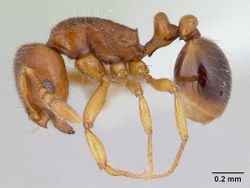Key to Oxyepoecus species
This worker key is based on: Albuquerque, N.L.d., Brandão, C.R.F. 2009. A revision of the Neotropical Solenopsidini ant genus Oxyepoecus Santschi, 1926 (Hymenoptera: Formicidae: Myrmicinae): 2. Final. Key for species and revision of the Rastratus species-group. Papéis Avulsos de Zoologia (São Paulo). 49: 289-309 (doi:10.1590/S0031-10492009002300001).
You may also be interested in
1
- Cephalic dorsum mostly smooth and shining; sculpture, if present, confined to anterior portions of genae and between the frontal carinae, where the costulae may prolong caudad into two patches always separated by a smooth median frontal stripe (Vezenyii Species-Group) . . . . . 2
- Cephalic dorsum either entirely sculptured, or if partially smooth, at least the median frontal stripe is covered by microsculpture (Rastratus Species-Group; also see the identification section of Oxyepoecus bidentatus, a species in this group but not included in this key, for distinguishing characters of O. bidentatus) . . . . . 11
2
return to couplet #1
- Mesosoma with irregular reticulate sculpture (better seen over 80X magnifications); head clearly longer than wide, (c.i. 70) . . . . . Oxyepoecus longicephalus
- Mesosoma lacking irregular reticulate sculpture; head clearly wider than long, (c.i. > 70) . . . . . 3
3
return to couplet #2
- Compound eye with more than 7 ommatidia across greatest diameter, total number of ommatidia more than 30 . . . . . 4
- Compound eye with less than 7 ommatidia across greatest diameter, total number of ommatidia less than 30 . . . . . 5
4
return to couplet #3
- Petiole antero-posteriorly compressed in a scale-like fashion, pronotum convex and rounded above, whole propodeum and metapleura with well marked costulae . . . . . 6
- Petiole not antero-posteriorly compressed but club shaped, integument almost entirely smooth and shining . . . . . Oxyepoecus punctifrons
5
return to couplet #3
- Propodeum saddle shaped; posterior margin of katepisternum and posterior face of the postpetiole smooth and shining . . . . . Oxyepoecus ephippiatus
- Propodeum dorsum at the same level of mesonotum, as in other species in the genus; posterior end of katepisternum and posterior face of postpetiole longitudinally costulate . . . . . Oxyepoecus inquilinus
6
return to couplet #4
- Antero-lateral margin of the pronotum in dorsal view rounded . . . . . 7
- Antero-lateral margin of the pronotum in dorsal view angulated . . . . . 8
7
return to couplet #6
- Metanotal groove not impressed (p.v.), overall size minute, the smallest of the Vezenyii species-group (1.7 mm) . . . . . Oxyepoecus kempfi
- Metanotal groove impressed (p.v.), overall size median in comparison with others species to the Vezenyii species-group (2.7 mm) . . . . . Oxyepoecus crassinodus
8
return to couplet #6
- Antero-lateral margin of the pronotum in dorsal view rounded, not forming an angle . . . . . Oxyepoecus vezenyii
- Antero-lateral margin of the pronotum in dorsal view forming an angle . . . . . 9
9
return to couplet #8
- Pronotal disk without costulae; subpostpetiolar process very much ventrally projecting, surpassing the level of the postpetiolar socket . . . . . Oxyepoecus bruchi
- Pronotal disk with costulae; subpostpetiolar process not much ventrally projecting, attaining at most the level of the postpetiolar socket . . . . . 10
10
return to couplet #9
- Dorsal margin of the petiole in lateral view rounded; length of the declivous margin of the propodeum less than half of the basal margin length . . . . . Oxyepoecus browni (Oxyepoecus striatus is not included in this key but is most similar to browni. See the identification section of Oxyepoecus striatus for characters that can separate these two species.)
- Dorsal margin of the petiole subquadrate; length of the declivous margin of the propodeum more than half the basal length . . . . . Oxyepoecus quadratus
11
return to couplet #1
- At least the posterior third of the pronotal lateral face covered by sculpture; katepisternum and metapleuron mostly covered by reticulations . . . . . 12
- Posterior third of pronotal lateral face mostly smooth (faint rugae covering at most the mesothoraxic spiracle in O. rastratus); katepisternum and metapleuron mostly covered by longitudinal costulae . . . . . 14
12
return to couplet #11
- Mesosoma and petiole dorsum entirely reticulate. Tiny compound eye with three ommatidia r.g.d. and circa five in all . . . . . Oxyepoecus myops
- Mesosoma and petiole node dorsum either smooth or covered by different sculpturing. Compound eye with more than 6 ommatidia . . . . . 13
13
return to couplet #12
- Head dorsum laterally and at vertex mostly smooth, costulae confined to median cephalic dorsum, sculpture on lateral pronotal face mostly effaced; katepisternum and metapleuron covered by reticulations only . . . . . Oxyepoecus rosai
- Head dorsum and vertex completely sculptured; lateral face of pronotum longitudinally costulate (sometimes reticulate), katepisternum and metapleuron irregularly reticulate and punctate, coarser on metapleuron . . . . . Oxyepoecus reticulatus
14
return to couplet #11
- Costulae on head dorsum prolonged caudad but not attaining posteriorly the vertex margin . . . . . Oxyepoecus plaumanni
- Costulae on head dorsum prolonged caudad and attaining posteriorly the vertex margin . . . . . 15
15
return to couplet #14
- Costulae on head dorsum prolonged laterally and do not reaching posterad of compound eye . . . . . Oxyepoecus daguerrei
- Costulae on head dorsum prolonged laterally and reaching posterad of compound eye . . . . . Oxyepoecus rastratus (Ulysséa & Brandão 2012 described Oxyepoecus regularis and it will be run to rastratus in this key. It is distinct from rastratus by the presence of thick, sub-parallel, regularly spaced and well marked costulae; laterals of pronotum longitudinally costulate and anterior pronotal inclination transversally costulate.

























